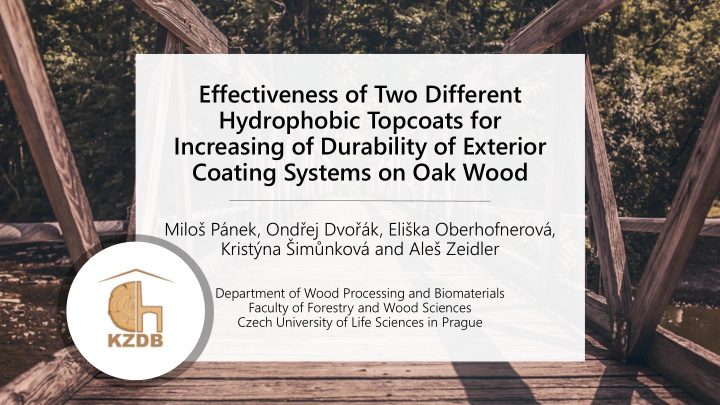



Effectiveness of Two Different Hydrophobic Topcoats for Increasing of Durability of Exterior Coating Systems on Oak Wood Miloš Pánek , Ondřej Dvořák , Eliška Oberhofnerová , Kristýna Šimůnková and Aleš Zeidler Department of Wood Processing and Biomaterials Faculty of Forestry and Wood Sciences Czech University of Life Sciences in Prague
WHY COATINGS ON OAK WOOD? Oak wood ( Qercus patreae , L): + + durable against bio-attack, + interesting colour and wood texture, - leaching of exctractives by rain causing pollution, - shorter durability of exterior coatings due to its specific structure and extractives content.
OBJECTIVES » E valuation of the efficiency of transparent and semi-transparent coating systems applied on oak wood. » P ossible enhancement of coating systems durability by application of hydrophobic layers.
MATERIALS AND METHODS » oak wood ( Qercus patreae , L.) » 24 transparent and semi-transparent coating systems on OIL (OL), ACRYLATE (AC), ALKYD (AL) and other SYNTHETIC (SL) polymer base » coatings without (a) or with 2 hydrophobic topcoats: SYNTHETIC (b) and ACRYLATE (c)
METHODOLOGY » artificial weathering together with temperature cycling » regular evaluation of color, gloss and contact angle change » visual evaluation (confocal laser scanning microscopy)
RESULTS Efficiency of hydrophobic layer on the color and gloss change after 6 weeks of AW
RESULTS Efficiency of hydrophobic layer on the contact angle change after 6 weeks of AW
RESULTS Visual ual chan anges ges of selected ected tested ed coatin ting g systems ems on oak wood OL-2a: Penetrating transparent oil - the same degradation was observed using hydrophobic treatments b and c; OL-9: Semitransparent oil creating thin layer - positive effect of hydrophobic treatment (c) on color stability of AW samples; OL-10: Semitransparent penetrating oil - partly positive effect of hydrophobic topcoat application b and c; AL-1: Transparent alkyd paint - very similar degradation was observed using hydrophobic treatments b and c; AL-4: Semitransparent alkyd coating - positive effect of pigment content increasing its durability (in comparison with transparent AL-1a); SL-1: Transparent synthetic coating - positive effect of application of topcoat b; SL-6b: Semitransparent synthetic coating - positive effect of application of topcoat b.
RESULTS Microsco oscopic pic chan anges ges (using g confocal ocal laser er scann nning ng microscopy oscopy) of c coati ating ng surface aces s OL-9a (A), OL-1a (B), OL-1c (C) and SL-6b (D) before (left) and after 6 weeks of AW (right). It is possible to see loss of gloss and color changes of OL-9a, but coating layer is not degraded (A); Positive effect of hydrophobic top coat (c) application on OL-1 is visible (B and C); Good durability of SL-6b after AW – only darkening is visible, surface is relatively unchanged.
CONCLUSIONS » Selection of the coating system can both positively itively and negatively tively affect the overall service life of oak wood in exterior. » Semi-transparent coating systems were more stable le than transparent ones. » The topcoat with hydrophobic additives in the acrylate ylate water er base: more appropriate for application on tested oak wood coatings in comparison with synthetic hydrophobic topcoat. » T op hydrop opho hobic bic layer yer improved oved mainly the properties of oil and partially acrylate coatings. » Further research needed for oak wood.
Th Thank nk you you for or your your attentio ention! PICTURES FROM: » www.pexels.com » Photos by: Eliška Oberhofnerová, Miloš Pánek
Recommend
More recommend